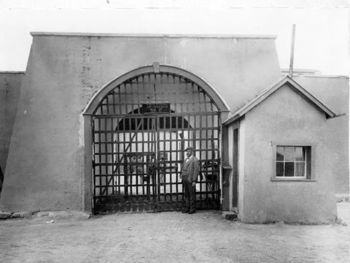News
Back to News
Monday marked a historic day for the Yuma Territorial Prison. The first inmates entered the prison on July 1, 1876, and built their own cells.
Soon after arriving in Yuma, seven prisoners from across Arizona started constructing the first two-and-a-half cells with rock. During the day, they toiled under the heat of the sun and at night they were locked up at the Yuma County Jail on Main Street.
Prisoner No. 1 was William Ball of Tucson. He had been sentenced to life for second-degree murder. He was released upon pardon by Acting Gov. H.W. Van Armand on July 24, 1884, but he returned twice more as Prisoner No. 414 and 581 for grand larceny.
Monday marked a historic day for the Yuma Territorial Prison. The first inmates entered the prison on July 1, 1876, and built their own cells.
Soon after arriving in Yuma, seven prisoners from across Arizona started constructing the first two-and-a-half cells with rock. During the day, they toiled under the heat of the sun and at night they were locked up at the Yuma County Jail on Main Street.
Prisoner No. 1 was William Ball of Tucson. He had been sentenced to life for second-degree murder. He was released upon pardon by Acting Gov. H.W. Van Armand on July 24, 1884, but he returned twice more as Prisoner No. 414 and 581 for grand larceny.
The repeat offender was a “criminal’s criminal,” as described by Tina Clark, city historian and museum curator of the Yuma Territorial Prison State Historic Park.
No one knows what Ball or the early prisoners looked like. No mugshots were taken of the first 235 prisoners.
“In this case, record-keeping wasn’t that great,” Clark noted.
Even after the prison started taking photographs of the inmates, only 50 of the first 700 mugshots still survive. Those early supervisors probably didn't imagine that the prison would become a major attraction, drawing more than 60,000 visitors a year.
But the museum still has thousands of prisoner documents, mugshots and rap sheets from its 33-year history. From 1876 to 1909, the prison housed 3,069 men and women convicted of crimes in the Arizona Territory.
The “Wild West” conditions in Arizona at the time convinced legislators that a prison was needed. It was after the Civil War and the nation was experiencing a westward migration. Some of these people were less than law-abiding and needed to flee their home states.
It was the time of the Gold Rush, the years 1849-50, when adventurers were heading to California through the two routes available. The southern route was in Yuma, across the “Mighty Colorado River,” which was a hundred times what it is today, Clark noted.
“The politicians knew there was a wave of people coming,” she said.
Members of the Territorial Legislature, including Jose Maria Redondo, a Yuma mayor, merchant, farmer and rancher, decided Arizona needed three things: a capital, a university and a prison. The capital went to Prescott, the University of Arizona went to Tucson, and the prison went to Phoenix.
However, Clark explained, Redondo had "other ideas. When the legislators went to lunch, he crossed out Phoenix for the prison, and put Yuma in its place. Redondo knew a prison would be a “great financial boon” to Yuma.
“He was right. Yuma did very well with the prison economy,” Clark said.
It meant jobs for the locals. Being a prison guard, which paid $90 a month, was considered a desirable job. The women of the day wanted their husbands to have that job, Clark said.
The prisoners weren’t skilled carpenters nor did they have construction experience. The architect overseeing the project told them how to do it. Conditions at the prison weren’t great. Historians don’t know who cooked the meals for those first inmates.
The cells built by the first prisoners are still there, and they stand out. While the roof line over the other cells is straight, the roof of the first cells follows the shape of the rocks.
A time capsule put in when the building started is also still there. There are no immediate plans to open it
Although the prisoners were ordered to construct their own cells in the middle of summer, no one protested. It was seen as part of the punishment for breaking the law. The prisoners, including murderers, weren’t seen with a lot of respect. They were considered free labor, Clark explained.
Yuma was home to people used to a tough life in the desert, the historian added.
The original colonies by that time had established cities such as Boston and New York. Those who left were the risk takers of their families, those who heard the call of adventure, Clark noted.
Those who had the guts to leave home and go west also had the guts to rob banks and commit other crimes.
Nevertheless, these crimes weren’t necessarily happening in Yuma, with potential criminals perhaps discouraged by the military presence here. Tombstone was the city of choice for many criminals. Other crimes were committed in other cities around the Arizona Territory.
“It was still the Wild West,” Clark said.
The photos and history of some of these prisoners are on display at the museum. With the majority of visitors coming to the park during the winter, summer is a good time to leisurely peruse the exhibits and cells.
This summer the park is building new exhibits, which Clark calls “exciting and wonderful.”
The park is open from 9 a.m. to 5 p.m. Thursday through Monday and closed on Tuesday and Wednesday. The cost is $8 for adults, $6 for seniors age 62 and over, $4 for children ages 7 to 13, and free for children 6 and under.
The park can be reached at 928-783-4771.


